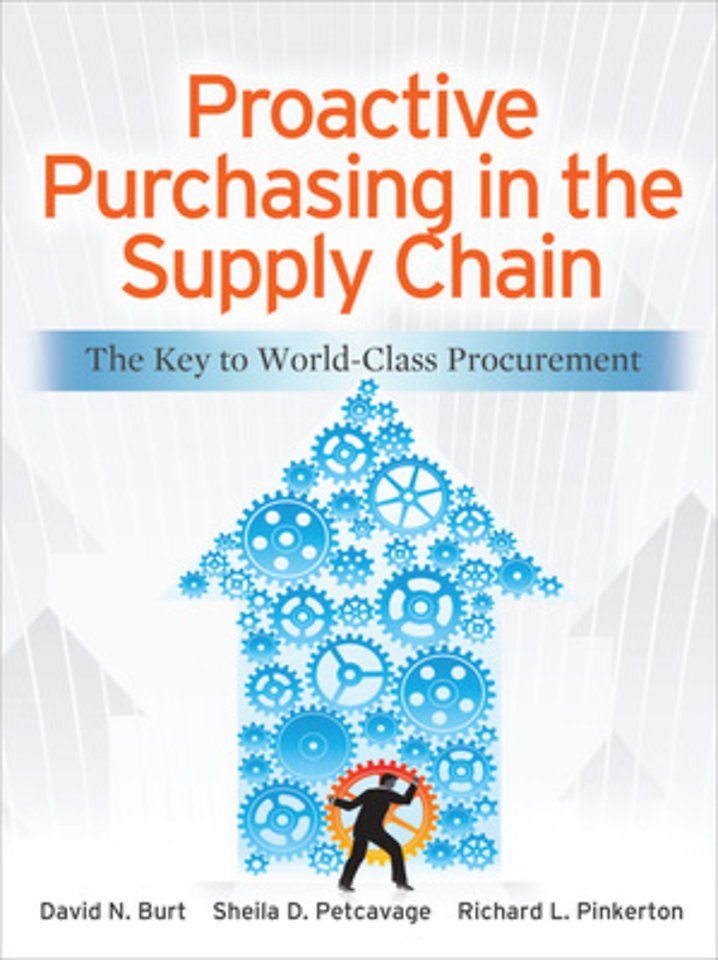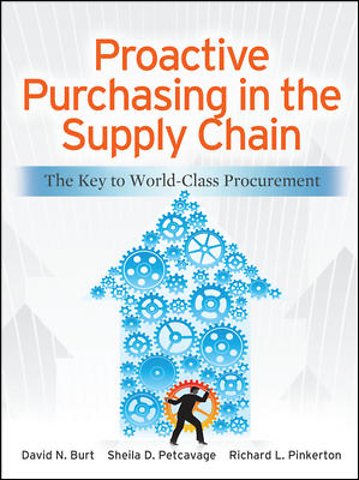Proactive Purchasing in the Supply Chain: The Key to World-Class Procurement
Samenvatting
Publisher's Note: Products purchased from Third Party sellers are not guaranteed by the publisher for quality, authenticity, or access to any online entitlements included with the product.
Transform purchasing operations from reactive to proactive supply management
Written for purchasing managers, Proactive Purchasing in the Supply Chain reveals how to use the latest and best procurement practices to help your organization maximize the effectiveness and efficiency of its supply chain. The ability of purchasing to dramatically increase return on investment, reduce costs, improve quality, and shorten time to market is highlighted throughout this practical guide.
Essential topics such as legal issues, green purchasing, negotiation, ethics, price-cost analysis, production-inventory control, purchasing risk management, sourcing, and demand-logistics management are addressed. Real-world case studies in each chapter demonstrate the strategies presented in the book. A detailed planning model for implementing these world-class procurement methods is also contained in this definitive resource.
The authors combine extensive industry, educational, research, and consulting experience to cover topics such as:The latest "best-in-class" purchasing methods, tools, procedures, and systemsPrice-cost analyses and how to fight price increasesHow to organize the purchasing department to achieve maximum value added in the supply chainGreen purchasingPurchasing risk management programs and proceduresHow to separate strategic from tactical buyingStep-by-step checklists for major purchasing functionsHow to overcome obstaclesForecasting methods for demand managementHow to transform the purchasing department from a cost center to a value-added operationSocial responsibility and ethical issuesPlanning steps and basic management skillsPreparation for relevant certification programs
Specificaties
Inhoudsopgave
re of the Make-or-Buy Decision <br/>Insourcing <br/>Dangers of Outsourcing <br/>Administration of Make-or-Buy Activities <br/>Chief Resource Officer <br/>Framework for Outsourcing <br/>Executive Level Involvement <br/>The Special Disadvantages of Outsourcing Business Processes <br/>Summary <br/>Endnotes <br/>Suggested Reading <br/>Chapter 13 Sourcing <br/>The Strategic Sourcing Plan <br/>Discovering Potential Suppliers <br/>Evaluating Potential Suppliers <br/>Selecting Suppliers <br/>Bidding vs. Negotiation <br/>Reverse Auctions <br/>Two-Step Bidding/Negotiation <br/>The Solicitation <br/>Weighted Factor Analysis <br/>Responsibility for Source Selection <br/>Developing Suppliers <br/>Managing Suppliers <br/>Additional Strategic Issues <br/>Early Supplier Involvement <br/>Supply Base Reduction <br/>Single vs. Multiple Sourcing <br/>Share of Supplier’s Capacity <br/>Local, National, and International Sourcing <br/>Manufacturer or Distributor <br/>“Green” Supply Management <br/>Minority- and Women-Owned Business Enterprises <br/>Ethical Considerations <br/>Reciprocity <br/>Consortium Purchasing and Group Buying <br/>Disaster Plans <br/>Summary <br/>Appendix <br/>Illustrative Plant Survey <br/>Financial Statement Analysis <br/>Planning a Facility Visit <br/>Endnotes <br/>Suggested Reading <br/>Chapter 14 Global Supply Management <br/>Global Management Perspective <br/>Future of Global Supply Management <br/>Stages to Global Supply Management <br/>Reasons for Global Sourcing <br/>Potential Problems <br/>Questions Before Going Global <br/>Supply Channels <br/>Global Trade Intermediaries <br/>International Procurement Offices <br/>Direct Suppliers <br/>Eliminating Intermediaries <br/>Identifying Direct Suppliers <br/>Qualifying Direct Suppliers <br/>Preparing for Direct Relations <br/>The Initial Meeting <br/>Currency and Payment Issues <br/>Exchange Rates <br/>Payments <br/>Letters of Credit <br/>Countertrade <br/>Countertrade’s Advantages <br/>Countertrade’s Disadvantages <br/>Supply Management’s Role <br/>Creative Countertrade <br/>Political and Economic Alliances <br/>European Union <br/>North American Free Trade Agreement <br/>MERCOSUR <br/>Association of Southeast Asian Nations <br/>Asia-Pacific Economic Cooperation <br/>Summary <br/>Appendix <br/>Currency Risk <br/>Hedging <br/>Endnotes <br/>Suggested Reading <br/>Chapter 15 Total Cost of Ownership <br/>Three Components of Total Cost <br/>Acquisition Costs <br/>Ownership Costs <br/>Post-Ownership Costs <br/>TCO, Net Present Value (NPV) Analysis, and Estimated Costs <br/>The Importance of Total Cost of Ownership in Supply Management <br/>Service Providers <br/>Retail <br/>Manufacturing <br/>Supply Chains/Supply Networks <br/>Summary <br/>Appendix: Supply Management in Action <br/>Endnotes <br/>Suggested Reading <br/>Chapter 16 Price and Cost Analysis <br/>Introduction <br/>General Economic Considerations <br/>Conditions of Competition <br/>Variable-Margin Pricing <br/>Product Differentiation <br/>Six Categories of Cost <br/>Regulation by Competition <br/>Price Analysis <br/>Competitive Price Proposals <br/>Regulated, Catalog, and Market Prices <br/>Internet/e-Commerce II <br/>Historical Prices <br/>Supply and Demand Factors <br/>Independent Cost Estimates <br/>Cost Analysis <br/>Cost Analysis Defined <br/>Capabilities of Management <br/>Efficiency of Labor <br/>Amount and Quality of Subcontracting <br/>Plant Capacity <br/>Sources of Cost Data <br/>Potential Suppliers <br/>Supply Partners <br/>Cost Models <br/>Direct Costs <br/>Direct Labor <br/>Direct Materials <br/>Tooling Costs <br/>Learning Curves <br/>Cumulative Curve and the Unit Curve <br/>Target Cost Estimation <br/>Indirect Costs <br/>Engineering Overhead <br/>Material Overhead <br/>Manufacturing Overhead <br/>General and Administrative <br/>Selling <br/>Recovering Indirect Costs <br/>Activity-Based Costing <br/>Target Costing <br/>Profit <br/>Resisting Arbitrary Price Increases <br/>Summary <br/>Appendix A: Application of Learning Curves <br/>Appendix B: Discounts <br/>Endnotes <br/>Suggested Reading <br/>Chapter 17 Methods of Compensation <br/>Introduction to Compensation Arrangements <br/>Observation <br/>Contract Cost Risk Appraisal <br/>Technical Risk <br/>Contract Schedule Risk <br/>General Types of Contract Compensation Arrangements <br/>Fixed Price Contracts <br/>Incentive Contracts <br/>Cost-Reimbursement Contracts <br/>Specific Types of Compensation Arrangements <br/>Firm Fixed Price Contracts <br/>Fixed Price with Economic Price Adjustment Contracts <br/>Fixed Price Redetermination Contracts <br/>Incentive Arrangements <br/>Fixed Price Incentive Fee <br/>Cost Plus Incentive Fee Arrangements <br/>Cost Plus Fixed Fee Arrangements <br/>Cost Plus Award Fee (CPAF) <br/>Cost without Fee <br/>Cost Sharing <br/>Time and Materials <br/>Letter Contracts and Letters of Intent <br/>Considerations When Selecting the Method of Compensation <br/>Summary <br/>Endnotes <br/>Suggested Reading <br/>Chapter 18 Negotiations <br/>Introduction <br/>Objectives of Negotiation <br/>Quality <br/>Fair and Reasonable Price <br/>On-Time Performance <br/>Control <br/>Cooperation <br/>Supplier Relationship Management <br/>When to Negotiate <br/>Supply Management’s Role in Negotiation <br/>The Supply Management Professional Acting Alone <br/>The Supply Management Professional as the Negotiating Team Leader <br/>The Negotiation Process <br/>Preparation <br/>Establishing Objectives <br/>Identify the Desired Type of Relationship <br/>Five Powerful Preparation Activities <br/>The BATNA <br/>The Agenda <br/>“Murder Boards” and Mock Negotiations <br/>Crib Sheets <br/>Draft Agreements <br/>Face-to-Face Discussions <br/>Fact Finding <br/>Recess <br/>Narrowing the Differences <br/>Hard Bargaining <br/>Techniques <br/>Universally Applicable Techniques <br/>Transactional Techniques <br/>Collaborative and Alliance Negotiating Techniques <br/>The Debriefing: An Incredible Learning Opportunity <br/>Documentation <br/>Online Negotiation <br/>Advantages to Online Negotiation <br/>An Example of a Successful Application of Negotiating Online <br/>Drawbacks to Online Negotiation <br/>Negotiating for Price <br/>Price Analysis Negotiation <br/>Cost Analysis Negotiation <br/>Characteristics of a Successful Negotiator <br/>Summary <br/>Endnotes <br/>Suggested Reading <br/>Chapter 19 Contract Formation and Legal Issues <br/>Litigation Prevention <br/>Dispute Resolution <br/>Negotiation <br/>Mediation <br/>Litigation <br/>Arbitration <br/>Courts <br/>Development of Commercial Law <br/>Electronic Contract Considerations: Cyber Law <br/>Attempts to Revise the UCC <br/>Basic Legal Considerations <br/>Status of an Agent <br/>The Purchase Contract <br/>Letters of Intent <br/>Special Legal Considerations <br/>Inspection Rights <br/>Rights of Rejection <br/>Title and Risk of Loss <br/>Warranties <br/>Evergreen Contracts <br/>Order Cancellation and Breach of Contract <br/>JIT Contracts <br/>Honest Mistakes <br/>Patent Infringement <br/>Restraint of Trade Laws <br/>International Considerations <br/>Contracts for the International Sale of Goods <br/>Foreign Corrupt Practices Act <br/>Summary <br/>Endnotes <br/>Suggested Reading <br/>Chapter 20 Contract and Relationship Management <br/>Need for Better Contract Management <br/>Preaward Conference: The Stage Has Been Set <br/>Monitoring and Controlling Project Progress <br/>Operations Progress Reports <br/>Gantt Charts <br/>CPM and PERT <br/>Closed-Loop MRP Systems <br/>Monitoring and Controlling Total Supplier Performance <br/>Supplier Performance Evaluation <br/>Motivation <br/>Punishment <br/>Rewards <br/>Assistance <br/>Transformational Training <br/>Quality Audits and Supply System Reviews <br/>Problem Solving <br/>Collaboration <br/>Managing the Relationship <br/>Summary <br/>Appendix A: Supplier Reporting Requirements for Unique Major Projects <br/>Appendix B: How Critical Path Scheduling Works <br/>Appendix C: Supplier Questionnaire <br/>Endnotes <br/>Suggested Reading <br/>Chapter 21 Ethics and Social Responsibility <br/>Ethics in the Supply Management Context <br/>Professional Supply Management Ethics <br/>Principles and Standards of Ethical Supply Management Conduct <br/>National and International Supply Management Conduct <br/>Important Areas Requiring Amplification <br/>Avoid Sharp Practices <br/>Competitive Bidding <br/>Negotiation <br/>Samples <br/>Treating Salespeople with Respect <br/>Substandard Materials and Services <br/>Gifts and Gratuities <br/>Management Responsibilities <br/>Written Standards <br/>Ethics Training and Education <br/>Departmental Environment <br/>Miscellaneous Factors <br/>Dealing with Gray Areas <br/>The Four Way Test <br/>Social Responsibilities <br/>Summary <br/>Endnotes <br/>Suggested Reading <br/>Chapter 22 Implementing World-Class Purchasing in the Supply Chain <br/>Designing an Effective Purchasing/Supply Management Department <br/>The Purchasing Planning Function <br/>Defining Planning <br/>Four Phases of Planning <br/>The Organizing Function <br/>The Five Basic Steps to Organizing <br/>Basic Concepts of Organizing <br/>Organizing for Supply Chain Management <br/>The Staffing Function <br/>The Directing Function <br/>Leadership <br/>Leadership and the Purchasing Profession <br/>The Controlling Function <br/>Evaluating the Purchasing/Supply Management Department <br/>The Annual Report <br/>Risk Management <br/>New Focus on Risk Management <br/>Appendix A: The Institute for Supply Management Awards for Excellence in Supply Management <br/>Appendix B: From Reactive to Proactive Procurement: A Case Study <br/>Appendix C: Raytheon Supply Base Optimization, April <br/>Appendix D: At Rolls-Royce North America, an Organizational Shift Is the Driving Force Behind an Innovative New Journey to Engage Its Supply Chain <br/>Endnotes <br/>Suggested Reading <br/>Epilogue The Future of Supply Management <br/>Index
Net verschenen
Rubrieken
- aanbestedingsrecht
- aansprakelijkheids- en verzekeringsrecht
- accountancy
- algemeen juridisch
- arbeidsrecht
- bank- en effectenrecht
- bestuursrecht
- bouwrecht
- burgerlijk recht en procesrecht
- europees-internationaal recht
- fiscaal recht
- gezondheidsrecht
- insolventierecht
- intellectuele eigendom en ict-recht
- management
- mens en maatschappij
- milieu- en omgevingsrecht
- notarieel recht
- ondernemingsrecht
- pensioenrecht
- personen- en familierecht
- sociale zekerheidsrecht
- staatsrecht
- strafrecht en criminologie
- vastgoed- en huurrecht
- vreemdelingenrecht

